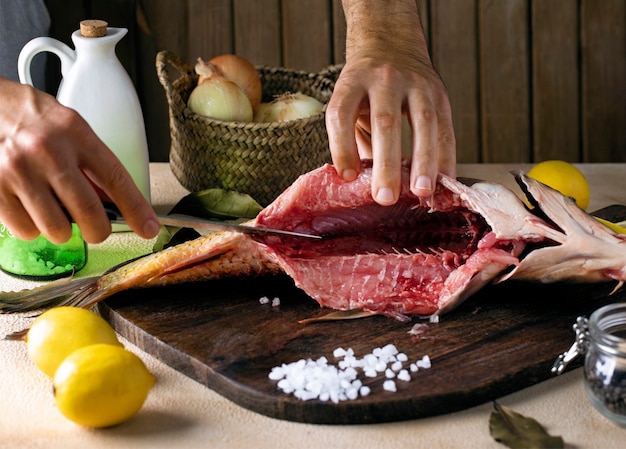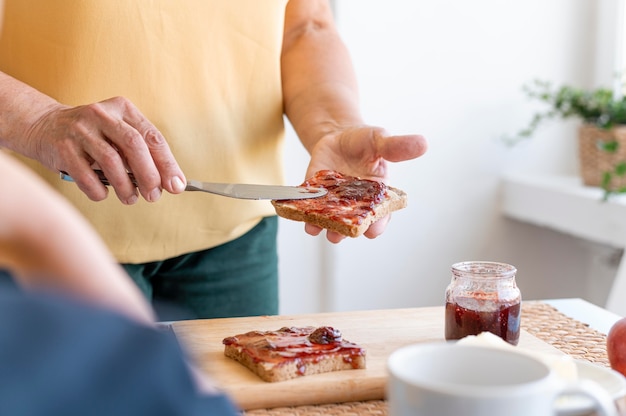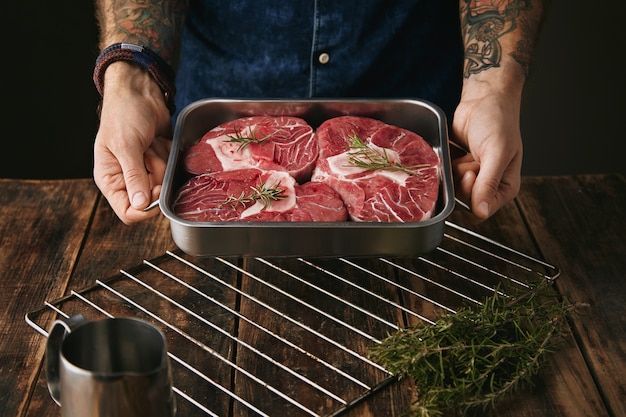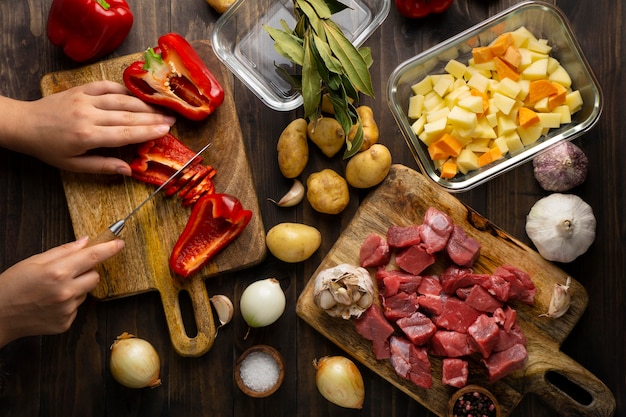Let’s be honest, there’s nothing quite like the satisfaction of a perfectly cooked ribeye steak. The sizzle, the aroma, the melt-in-your-mouth tenderness, it’s a culinary experience that elevates a simple meal to pure joy. Over the years, I’ve spent countless hours in the kitchen experimenting and perfecting my ribeye technique, and I’m ready to share my secrets with you. This isn’t just a recipe, it’s a journey into the heart of steak cookery, packed with tips, tricks, and personal insights that will elevate your steak game to a whole new level.
(Part 1) The Foundation: Choosing and Preparing the Steak

Selecting the Perfect Ribeye
You can’t build a great steak experience without the right foundation, and that starts with choosing the perfect ribeye. Now, I’m a firm believer in quality, so don’t skimp! Look for a steak that has a generous amount of marbling, those beautiful white streaks of fat running through the meat. Marbling is the key to juiciness and flavour. A good ribeye should be at least 1 inch thick to ensure even cooking. And don’t be afraid to ask your butcher for advice! They are experts and can help you pick the perfect cut for your needs.
Pat It Dry, Pat It Dry
Once you’ve got your star ingredient, it’s time to prep it. Pat the steak dry with kitchen paper. This might seem like a small step, but it’s essential. A dry surface allows for a more even cook and helps create that beautiful, crispy sear we all crave.
Seasoning: Let Your Steak Sing
Now, here's where the fun begins! I’m a purist at heart, so I usually stick to salt and pepper. But feel free to get creative! A sprinkle of garlic powder, onion powder, smoked paprika, or even a touch of cayenne pepper can add a whole new dimension to your steak. Remember, less is more when it comes to seasoning. You want to enhance the natural flavours, not overwhelm them.
(Part 2) The Art of the Hot Pan: Setting the Stage

The Importance of a Smoking Hot Pan
A hot pan is the maestro of a great steak. It’s what creates that irresistible crust and seals in all those precious juices. We’re talking about a pan so hot it’s almost smoking, so don’t shy away from cranking up the heat.
Cast Iron or Stainless Steel? Your Choice, My Friend
Now, many people swear by cast iron pans for their heat retention, and I understand the appeal. But honestly, a good heavy-bottomed pan of any kind will do the trick. I personally have a trusty stainless steel pan that gets the job done beautifully.
Oil Up: The Lubricant of Flavor
Pour a generous amount of oil into your pan. I prefer a neutral oil like vegetable oil or canola oil, as they have a high smoke point. You don’t want your oil to start smoking before your steak goes in!
(Part 3) The Sizzle: A Culinary Symphony

Hitting the High Notes
Once your pan is sizzling and the oil is shimmering, gently place your steak in the pan. You’ll hear that unmistakable, joyous sizzle as the meat hits the heat – a sound that signals the start of a delicious journey.
The Art of Patience: Let It Cook
Now, resist the temptation to move it around! Let the steak cook undisturbed for about 3-4 minutes on each side. We’re aiming for a beautiful, dark crust. You’ll know it’s ready when you can easily lift it from the pan without it sticking.
Flip it Over: The Second Act
Carefully flip the steak over. You might hear that satisfying sizzle again as it makes contact with the pan.
The Edge of Perfection: A Finishing Touch
After searing both sides, use tongs to sear the edges of the steak. This adds a lovely touch of flavour and helps cook it more evenly.
(Part 4) A Moment of Rest: The Steak's Encore
Why Resting is Key
It might seem counterintuitive, but resting your steak is as important as any other step. Allowing the steak to rest for a few minutes lets the juices redistribute, resulting in a more tender and juicy final product.
Resting Time: 5-10 Minutes of Bliss
Rest your steak for at least 5-10 minutes before slicing and serving. I often use a wire rack placed over a baking sheet to rest the steak. This allows for airflow and prevents the juices from pooling.
Cover it Up: Keeping the Heat In
Cover the steak loosely with foil to keep it warm while it rests.
(Part 5) Mastering the Doneness: Finding Your Perfect Note
Temperature Guide: Your Steak's Score
Everyone has their own preferences when it comes to steak doneness, and that’s a beautiful thing! Here’s a handy temperature guide to help you find your perfect note:
| Doneness | internal temperature (°F) | Internal Temperature (°C) | Description |
|---|---|---|---|
| Rare | 125-130 | 52-54 | Red center, cool to the touch |
| Medium Rare | 130-135 | 54-57 | Pink center, warm to the touch |
| Medium | 135-140 | 57-60 | Slightly pink center, hot to the touch |
| Medium Well | 140-145 | 60-63 | Very little pink center, hot to the touch |
| Well Done | 145-150 | 63-66 | No pink center, very hot to the touch |
The Thermometer: Your Steak's Conductor
To achieve perfect doneness, use a meat thermometer. Insert it into the thickest part of the steak, ensuring you don’t touch the bone. When it reaches your desired temperature, remove the steak from the pan.
(Part 6) Finishing Touches: The Grand Finale
The Butter Touch: A Rich Accordion
After removing the steak from the pan, add a knob of butter to the hot pan. Let it melt and brown slightly. Then, spoon the melted butter over the steak. This adds a rich, buttery flavour and a beautiful sheen.
Herbs: A Symphony of Aroma
Don’t forget the herbs! A sprinkle of fresh herbs like parsley, thyme, or rosemary can add a burst of fresh flavour.
Rest Again: The Final Curtain Call
After adding the butter and herbs, let the steak rest for another minute or two before slicing and serving.
(Part 7) Serving Your Masterpiece: A Culinary Concert
Slicing: The Art of the Encore
When it’s time to serve, slice the steak against the grain. This technique helps to tenderise the meat and make it easier to chew.
side dishes: A Supporting Cast
Pair your perfectly cooked ribeye with your favourite side dishes. I love a simple salad, roasted vegetables, or some creamy mashed potatoes.
The Grand Finale: Enjoy!
Now, sit back, relax, and enjoy the fruits of your labour! Savor the flavour, the texture, the symphony of taste you’ve created.
(Part 8) Tips and Tricks: Variations on a Theme
reverse searing: The Avant-Garde Approach
For those who like a little culinary adventure, try reverse searing. This technique involves cooking the steak to just below your desired doneness in the oven, then searing it in a hot pan to get that crispy crust. It’s a bit more time-consuming, but it results in a perfectly tender and evenly cooked steak.
Resting: The Importance of a Calm Finale
It’s easy to get impatient, but resting the steak is vital. It allows the juices to redistribute, resulting in a more tender and juicy steak. Resist the urge to cut into it right away!
Don't Overcook It!: A Cautionary Note
This is a common mistake, and it can turn a delicious steak into a dry and tough one. Use a meat thermometer to check the internal temperature and remove it from the heat when it reaches your desired doneness.
Seasoning: Balancing the Flavors
Less is more when it comes to seasoning. A simple salt and pepper will do just fine. You can always add a touch of garlic powder, onion powder, or smoked paprika for a bit more flavour.
Pan Temperature: The Heat of the Moment
A hot pan is crucial for a good sear. Make sure your pan is smoking hot before you add the steak.
Oil: The Lubricant of Flavor
Use a neutral oil like vegetable oil or canola oil, as they have a high smoke point.
Don't Crowd the Pan: Space for Excellence
If you’re cooking multiple steaks, don’t crowd the pan. This will lower the temperature of the pan and prevent the steaks from getting a good sear.
FAQs: Addressing the Notes
Q: How do I tell if a ribeye is good quality?
A: Look for a ribeye with a good amount of marbling, those beautiful white streaks of fat running through the meat. It’s what gives the steak its juiciness and flavour. The steak should also be at least 1 inch thick for even cooking.
Q: What’s the best way to season a ribeye?
A: A simple salt and pepper seasoning is usually enough. You can also add a touch of garlic powder, onion powder, or smoked paprika for a bit more flavour.
Q: How do I know when my ribeye is cooked to my liking?
A: Use a meat thermometer to check the internal temperature of the steak. The temperature will vary depending on your desired doneness. You can also use the “touch test” by pressing on the steak, but this is less accurate.
Q: What are some good side dishes to serve with a ribeye steak?
A: Simple sides like a salad, roasted vegetables, or creamy mashed potatoes are perfect with a ribeye.
Q: How do I get a good sear on my ribeye?
A: A hot pan is essential for a good sear. Make sure your pan is smoking hot before you add the steak. Let it cook undisturbed for 3-4 minutes on each side, or until it develops a nice, dark crust.
Everyone is watching

Perfect Rice Every Time: The Ultimate Guide to Cooking Rice
Cooking TipsAs a self-proclaimed foodie, I've always been a bit obsessed with rice. It's the foundation of countless cuisi...

Ultimate Guide to Cooking the Perfect Thanksgiving Turkey
Cooking TipsThanksgiving. Just the word conjures up images of overflowing tables laden with delicious food, the scent of r...

The Ultimate Guide to Cooking Asparagus: Tips, Techniques, and Recipes
Cooking TipsAsparagus. The mere mention of this spring delicacy conjures up images of vibrant green spears, crisp and burs...

Can You Cook Spaghetti with Gasoline? (The Shocking Truth)
Cooking TipsWe've all seen those crazy internet trends. You know, the ones that make you wonder, "Did someone actually try...

Chorizo and Eggs Recipe: The Ultimate Guide
Cooking TipsRight, let’s talk about chorizo and eggs. You know, that classic Spanish dish that's always a winner. It's th...
